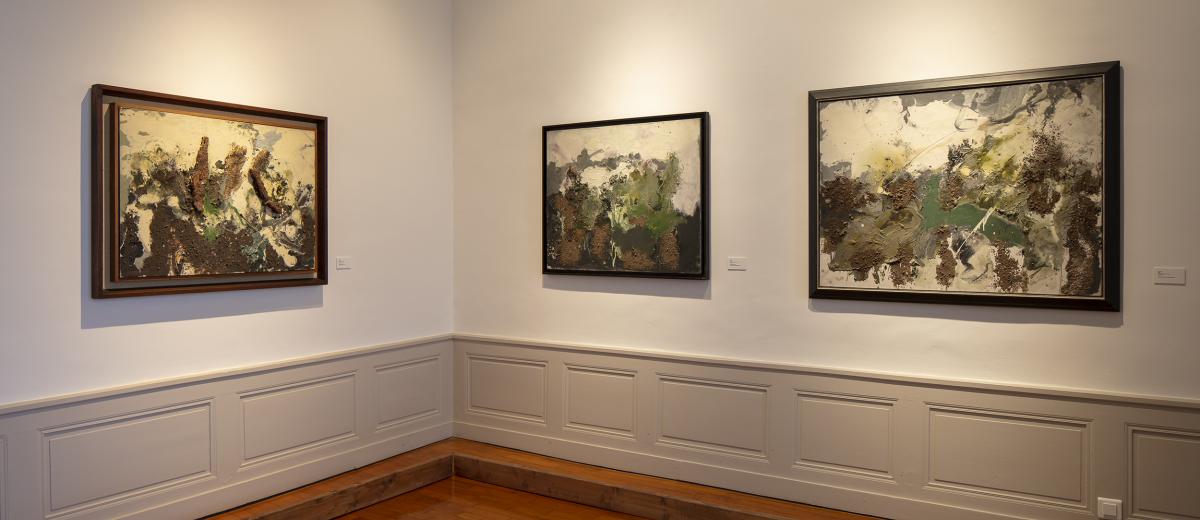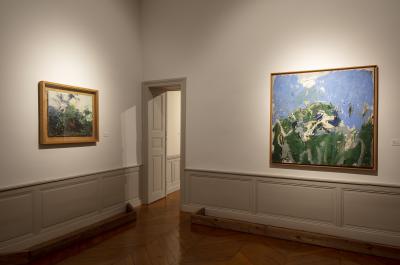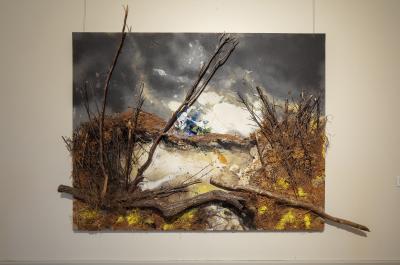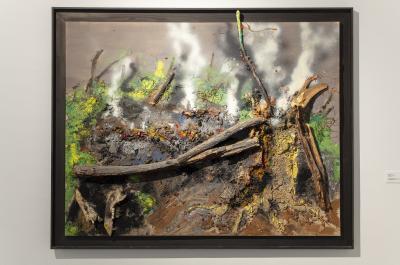A. Paul Rebeyrolle
"Paysages"

It is undoubtedly partly due to the fact that he felt constraint within his own body very early on - immobilised at the age of 5 by tuberculosis of the bone until his tenth birthday - that the work of Paul Rebeyrolle, born in 1926, is marked by vitality. Enormous amounts of energy emerge from his paintings and sculptures. The artist said himself that he embraced life from the minute he woke up, every morning as he rose, and was always delighted to get to work in his studio, to start creating.
He learnt a great deal during the years he spent recovering in his hometown in the Limousin region of France. Even in plaster, he never ceased to draw and paint. He was a lively man, and that was reflected in his art, which grew up alongside him. Nostalgia and dreams of his childhood had no place in his work, which was firmly rooted in the current times. That’s how his multiple series came to be, spread across the fifty-seven years of his career, from 1948 to 2005. More than just being up-to-date with current trends, Stéphane Vacquier would even go as far to speak of punctuality, because that is the extent to which his paintings reflect the issues of each era and portray a sort of uncompromising foresight.
In 1995, he was present for the official opening of his very own museum, the Espace Paul Rebeyrolle in Eymoutiers. This original art centre was designed with architect Olivier Chaslin, and the artist, a friend of Georges Guingouin, created it as a place of cultural resistance, a ‘stronghold’. A permanent addition to the collections was his tribute to his friend, member of the Resistance, known as Le Cyclope. Apart from his collection, this venue is also available for temporary exhibitions from other artists, far from the ‘commodification’ of art.
In 2005, he painted his last works, with the rather suggestive titles: Le Néant (Nothingness) 1, 2 and 3. The last one dates from February of that year. He died on the 7th... Right up until the very end, this extraordinary artist blended his life and his art, working and breathing in the very same respiration.
BIOGRAPHICAL NOTES

Paul Rebeyrolle was born in 1926 in Eymoutiers (Haute-Vienne). In 1931 he was diagnosed with tuberculosis of the bone and was in plaster for five years. Later, he went to study in Limoges. At the age of 18, he went to Paris where he developed his knowledge of painting. He took up residence at La Ruche and met Madeleine Tellikdjian, nicknamed Papou, who he went on to marry in 1967. Between 1947 and 1949, he took part in the ‘Homme-Temoin’ (Man as Witness) movement, which prompted the return to Realism. Very quickly, he was considered a leader of the figurative ‘Jeune Peinture’ (Young Painter) movement, even though he refused to be part of a trend and travelled as much as he could.
In 1953, he joined the Communist Party. He broke with this party at the time of the Soviet invasion of Hungary in 1956, and painted a canvas called À bientôt j’espère (I hope to see you soon), to mark the occasion.
In 1959, at the age of 33, he was awarded First Prize at the first Paris Biennale, with a monumental painting measuring 4.20 x 18m, entitled Planchemouton. This commissioned work was intended for the staircase at the Palais des Beaux-Arts (Palace of Fine Arts).
In 1963, he left Paris and settled with Papou in Aube. His work was displayed for the first time at the Maeght Gallery in Paris, a series of paintings entitled Les Instruments du Peintre, where matter was given a key role. He was one of a hundred artists invited to Cuba for the Salon de Mayo, and he contributed to a 55 m2 fresco. He also created Le Sol de Cuba I and II, which were the beginning of the series Guérilleros.
From 1968, he began working on a cycle of ‘political’ series. He depicted the Cold War in his series Coexistences (1970), the catalogue for which was prefaced by Jean-Paul Sartre. Three years later, he unveiled the series Les Prisonniers, and this time the catalogue was prefaced by Michel Foucault. He then followed on with the series Faillite de la science bourgeoise, Natures mortes et pouvoir and Grands Paysages.
In 1979, he was one of the rare living artists to have a retrospective exhibition held in his name at the National Galleries of the Grand Palais. A great number of artists came before him, including Picasso, Chagall, Hélion, Beaudin, Bacon, Dubuffet, Miró and Ernstet Tal-Coat.
In 1982, he completed the series Les Évasions manquées with no less than 60 paintings. Then he went on to produce the series On dit qu’ils ont la rage (1984), Germinal (1986) and Au Royaume des aveugles (1987), Les Grandes têtes (1989), Les Panthéons (1990), and Splendeur de la vérité (1993).
In 1995, upon request from the Mayor of Eymoutiers, he agreed to unveil his own museum, the Espace Paul Rebeyrolle, on the condition that thevenue would reflect him, and not become a museum that stands still, rather a place that is open and an integral part of the surroundings, a far cry from typical mainstream art. In 2002, he created a garden of sculptures here.
In 2003, he completed the series Clones in which he covers the abuses of science. Nineteen of these paintings are on display at the Claude Bernard Gallery.
He passed away on the 7th February 2005 at the age of 78, after completing his final paintings, Le Néant (Nothingness) 1, 2 and 3.


